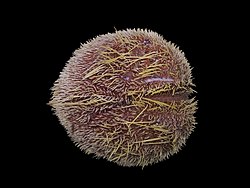| Heart urchins Temporal range: | |
|---|---|
 | |
| Spatangus purpureus | |
| Scientific classification | |
| Domain: | Eukaryota |
| Kingdom: | Animalia |
| Phylum: | Echinodermata |
| Class: | Echinoidea |
| Subclass: | Euechinoidea |
| Infraclass: | Irregularia |
| Superorder: | Atelostomata |
| Order: | Spatangoida L. Agassiz, 1840 |
| Suborders | |
The heart urchins are members of the order Spatangoida of sea urchins. Their body are somewhat elongated ovals in form, and are distinguished by the mouth being placed towards one end of the animal, and the anus towards the other. As a result, unlike most other sea urchins, heart urchins are bilaterally symmetrical, and have a distinct anterior surface. The presence and position of the mouth and anus typically give members of this group the distinct "heart" shape from which they get their common name. Heart urchins have no feeding lantern, and often have petaloids sunk into grooves. They are a relatively diverse order, with a number of varying species.











